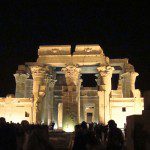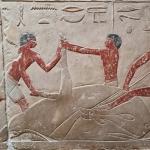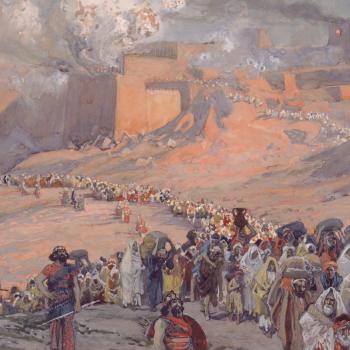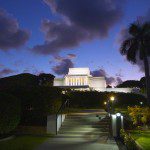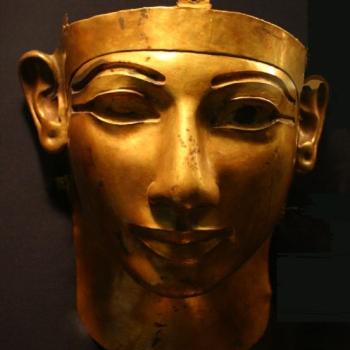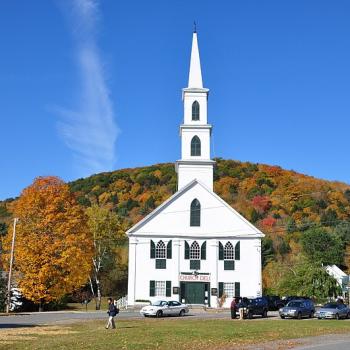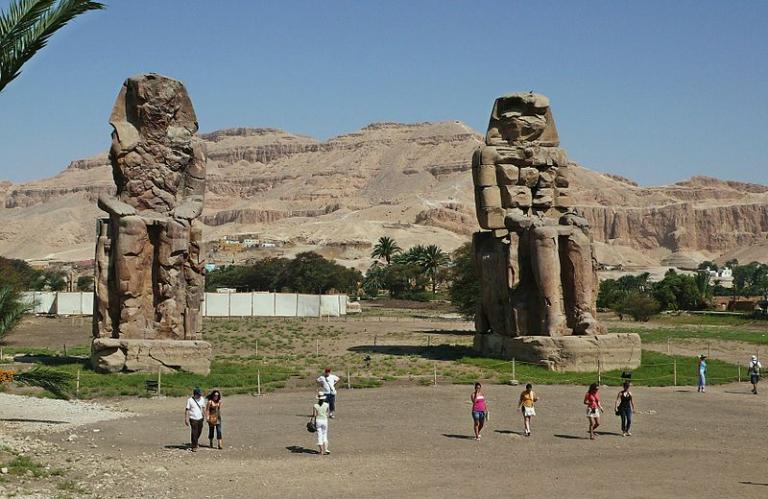
Most of us were up very, very early this morning for hot-air balloon rides over the temples and tombs and fields on the west bank of the River Nile. Then, after breakfast back on our boat, the Blue Shadow, we headed off for a visit to the Valley of the Kings, where most of us visited the tombs of Ramses IV, Ramses IX, Merneptah, and, of course, Tutankhamen. We then dropped by the temple of Queen Hatshepsut, which I have always found simply stunning and near which is the tomb in which the Joseph Smith Papyri were found. After spending some time (and, in more than a few cases, some money) at an “alabaster factory” near the Valley of the Nobles, we paused briefly at the so-called “Colossi of Memnon” – the two massive and ravaged sculptures of Pharaoh Amenhotep III that are almost all that remains of his once-grand mortuary temple – where I subjected the bus to my reading of Percy Bysshe Shelley’s poem ‘’Ozymandias.” It always strikes me acutely relevant when we visit the Colossi:
I met a traveller from an antique land,
Who said—“Two vast and trunkless legs of stone
Stand in the desert. . . . Near them, on the sand,
Half sunk a shattered visage lies, whose frown,
And wrinkled lip, and sneer of cold command,
Tell that its sculptor well those passions read
Which yet survive, stamped on these lifeless things,
The hand that mocked them, and the heart that fed;
And on the pedestal, these words appear:
My name is Ozymandias, King of Kings;
Look on my Works, ye Mighty, and despair!
Nothing beside remains. Round the decay
Of that colossal Wreck, boundless and bare
The lone and level sands stretch far away.”
After lunch and a brief break — it has been very, very hot — we headed off to visit the astoundingly vast temple of Karnak and to take a carriage ride through the back streets of the modern city of Luxor.
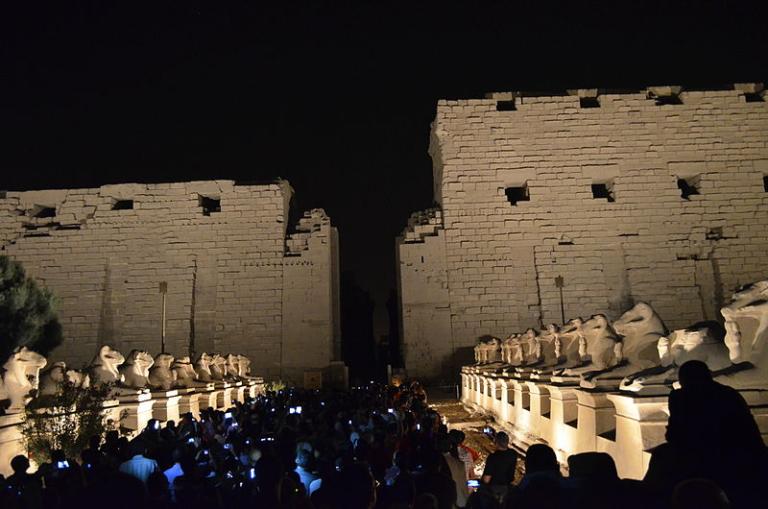
(Wikimedia Commons public domain photo)
Back once more, though, to BYU Studies Quarterly 61/4 (2022), the special issue of BYU Studies that was created by the faithful Latter-day Saint Egyptologists Stephen O. Smoot (Ph.D. candidate, Catholic University of America), John Gee (Ph.D., Yale University), Kerry Muhlestein (Ph.D., University of California at Los Angeles), and John S. Thompson (Ph.D., University of Pennsylvania) under the title A Guide to the Book of Abraham. In these entries (though a little less so in this particular one), I’m typically giving you bottom-line statements, without supplying any of the supporting evidence and argument. If you’re at all interested, I hope that you’ll obtain a copy of the issue yourself, so that you can judge for yourself how strong their case is:
“The Ancient Egyptian View of Abraham,” pages 197-200
Some might ask how likely it would have been for the ancient Egyptians to have known anything about the biblical figure Abraham. In fact, evidence survives today indicating that stories about Abraham were known to the ancient Egyptians as early as the time of the composition of the Joseph Smith Papyri (ca. 330-30 BC).
The earliest documented appearance of the biblical story of Abraham in ancient Egypt dates to the third century BC. (197). [It’s the Septuagint.]
In addition to the biblical text, extrabiblical stories about Abraham circulated in Egypt during this time. For example,
- “during the reign of Ptolemy I, Hecateus of Abdera traveled to Thebes and learned stories about Abraham from Egyptian priests; he wrote these stories in a book called On Abraham and the Egyptians. This work is now unfortunately lost, but Clement of Alexandria, a second-century AD Egyptian Christian, quoted a short passage from it in which the worship of idols is condemned.”
- “The writer Eupolemus, who lived under Egyptian rule in Palestine in the second century BC, recounts how Abraham lived in Heliopolis (On) and taught astronomy and other sciences to the Egyptian priests. In connection with Abraham, Eupolemus seems to think that the Egyptians descended from Canaan.”
- “In the first century BC, the Egyptian Jew Artapanus wrote an account of Abraham teaching astronomy to the Egyptian Pharaoh.”
- “Philo, a first-century AD Egyptian Jew, claimed that Abraham studied astronomy, the motion of the stars, meteorology, and mathematics, and used his reasoning on these subjects to understand God.”
- “The Testament of Abraham describes Abraham’s tour of the next life before he dies. Scholars think that this work was written by an Egyptian Jew around the first century AD. It is notable for its reinterpretation of the Egyptian judgment scene in a Jewish fashion. This text was read liturgically the Sunday before Christmas during the Egyptian month of Khoiak.”
- “[A] fragmentary text from Egypt about Abraham describes how the king (the word used is pharaoh) tries to sacrifice Abraham, but Abraham is delivered by an angel of the Lord. Abraham later teaches the members of the royal court about the true God using astronomy. (197-198)
[The similarities to the Book of Abraham should be obvious to anybody who is even casually acquainted with it.]
From the evidence of the Greek Magical Papyri, we can conclude that “a group of priests from Thebes possessed, read, understood, and employed biblical and extrabiblical texts, most especially texts about Abraham and Moses.” This evidence, along with the other evidence for a knowledge of Abraham circulating in ancient Egypt, bolsters confidence in the Book of Abraham’s authenticity by providing it with a plausible ancient Egyptian historical and literary context. (200)
“The Ancient Owners of the Joseph Smith Papyri,” pages 201-205
As a priest in Thebes, Hor would have been highly literate and would have had access to texts about Abraham and other Jewish figures. As a prophet of Amun-Re, he would have had an interest in themes such as temple-initiation, seeing God face-to-face, and creation. As a prophet of both Amun-Re and Min-Who-Massacres-His-Enemies, he would have “had a professional interest in . . . stories about slaughtering and then burning people on an altar.” Finally, as a prophet of the god Khonsu, he would have been attracted to a text that featured angels, contact with foreign lands, and a king who takes any woman he thinks is beautiful. These elements are, of course, prominent in the Book of Abraham. (264)
Posted from Luxor, Egypt


